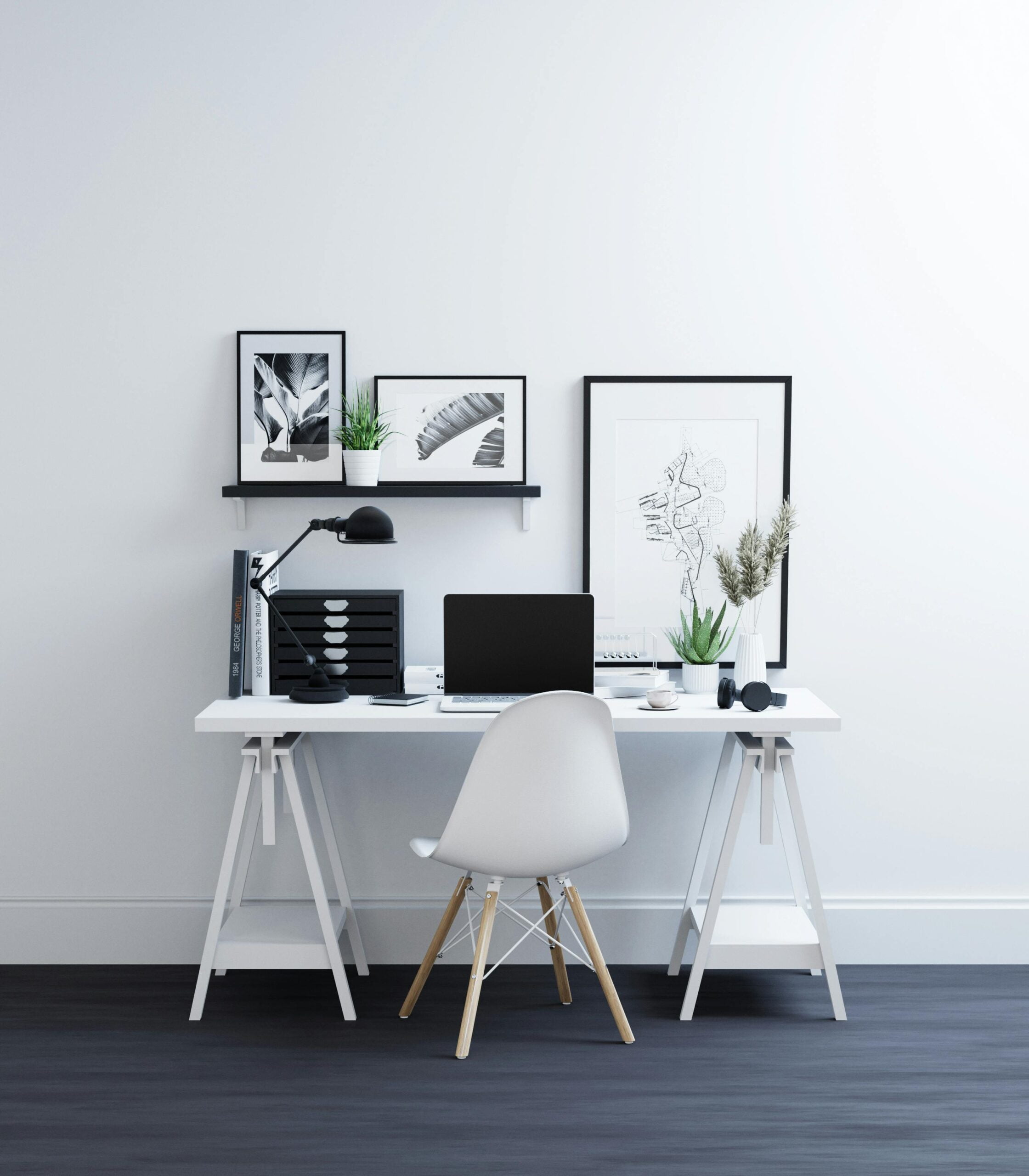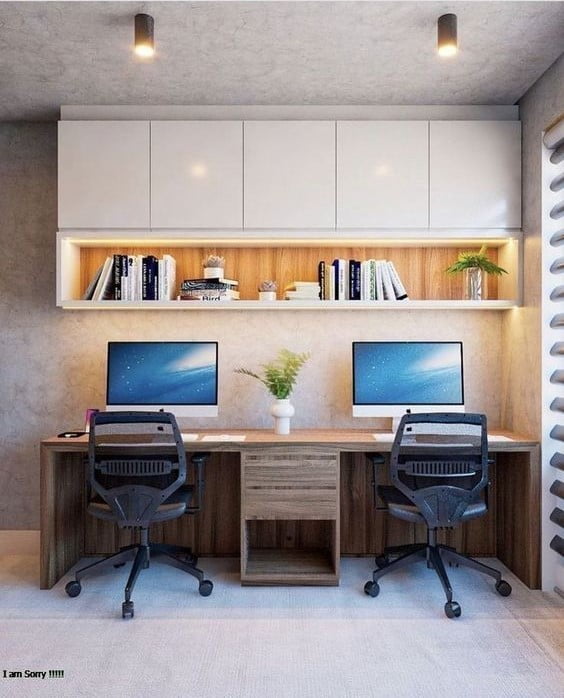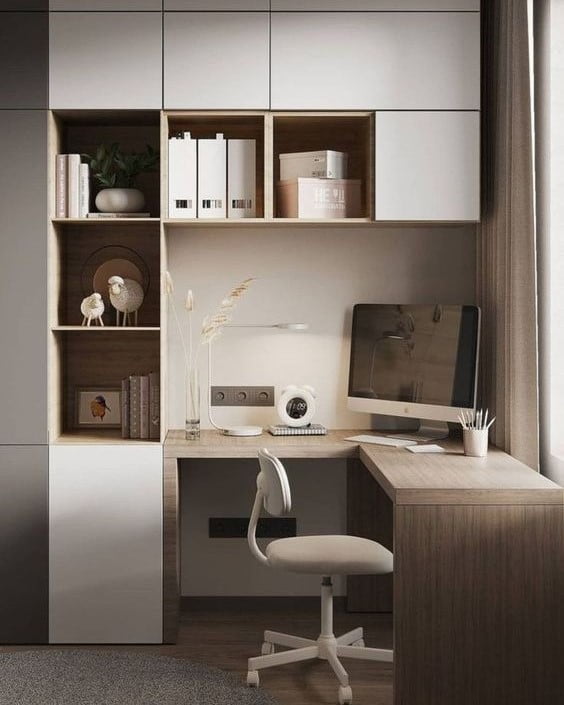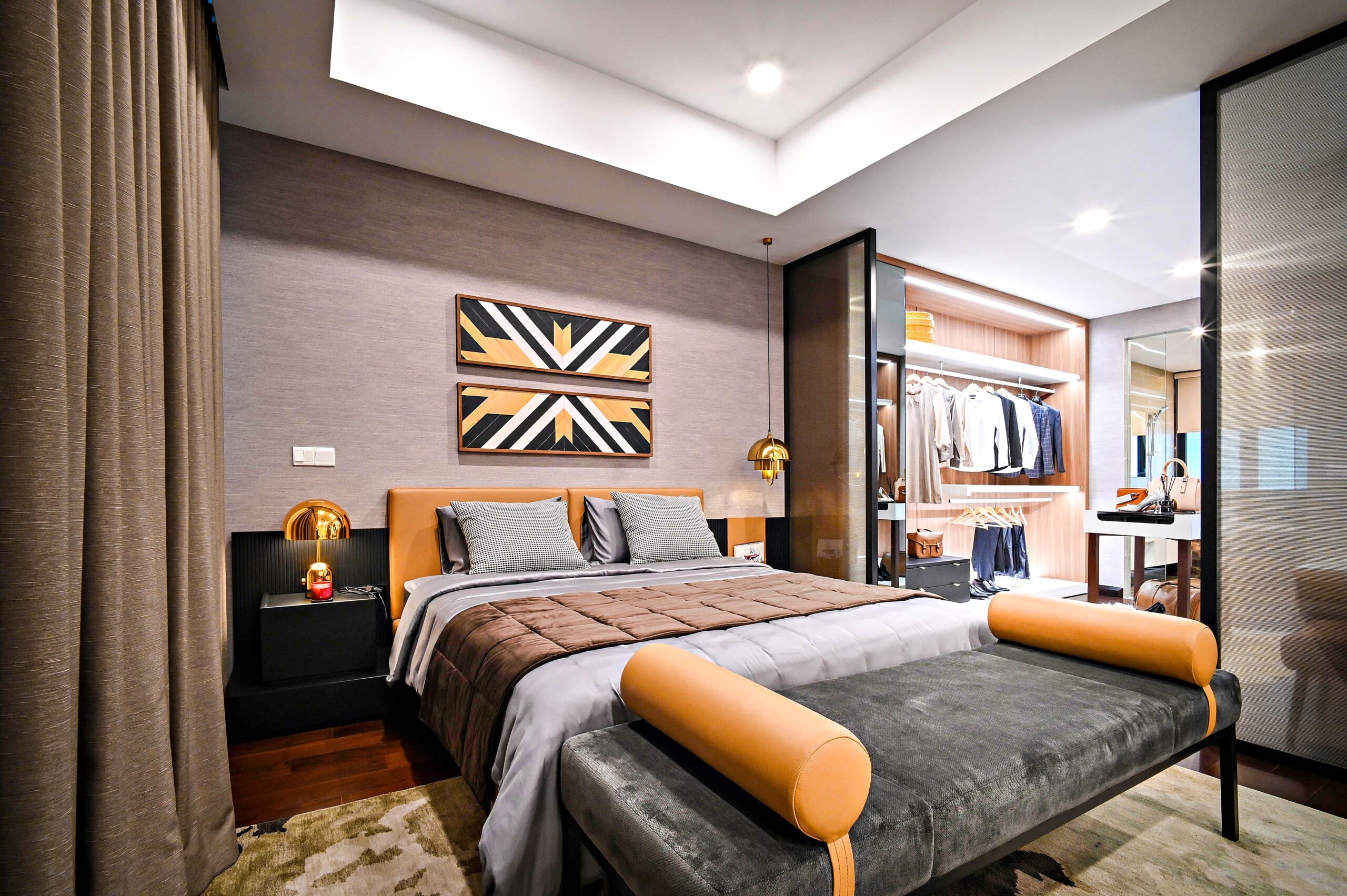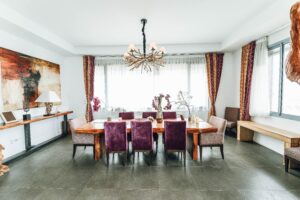Basic Definition of Study Room
A study room or area is a space that is dedicated to focused study, work, and intellectual pursuits. It serves as a focused environment where individuals can engage in learning, reading, writing, working, or other scholarly pursuits without distractions. A dedicated study area also promotes good posture and ergonomics that are comfortable for long-term studying and working without any problems or discomforts. A study room or area typically consists of these elements: a desk, a study table, comfortable seating, adequate natural or artificial air and lighting, storage space for books and other study materials, a laptop, a computer, notebooks, and other important things related to the study room.
In the era of working from home, mainly after COVID-19, a dedicated office space or study area is also required in every other house. It makes it easy to work from home without any additional requirements and brings comforts to the users. The layout of the study room or area should be designed in such a way that it promotes concentration, productivity, and creativity, providing users with a conducive environment for deep thinking and learning.
A study room is not only a well-designed workspace with appropriate dimensions, but it also has many other additional benefits: –
- It provides a personalized, dedicated space for studying.
- It provides comfort to the user and is sufficient for small meetings.
- Provides a calm area for working, reading, and learning.
- A study room allows users to work and rest at the same time.
- It is good for keeping or storing all study and work-related documents.
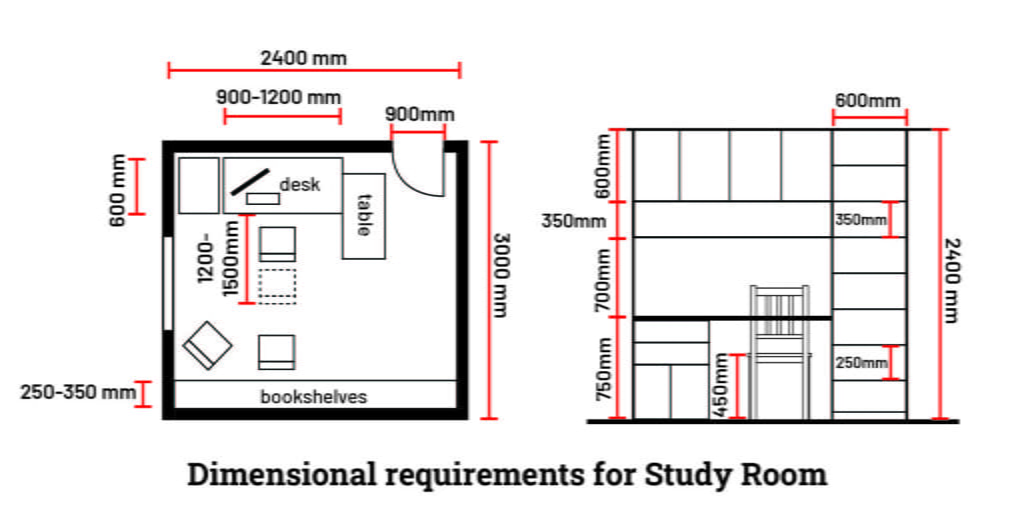
History of Study Room
Throughout history, the study room has evolved and developed from a closet or cabinet from the Renaissance era. In the beginning of the 18th century, when the literacy rate started increasing in middle-class families, they started constructing a dedicated study area or library area within the larger houses. [1] This space was not just dedicated to studying; they used it for commercial activities, reading, fact-checking, and other important activities that needed privacy, silence, concentration, and comfort.
The availability of cheap computers, Internet links, fax machines, etc. has made it possible for many people to work at home in a way that was inconceivable in the 1980s. While it has been traditional for some people to work from home, it is now becoming possible for many others; it has been estimated by the late 1990s that about 70% of all small-business start-ups were home-based. A separate room was essential, preferably on the ground floor; for reasons of privacy, noise, and security, it is necessary for this room to be apart from the general living area. (Source: The Architects’ Handbook, Edited By Quentin Pickard RIBA)
In the 20th century, study areas became an essential space in a residence where they could read, study, or work in peace. During COVID-19, the world was sitting inside houses and unconnected from outside activities. Still, we have to work and study. Then the importance of the study room was much appreciated by the people because it promoted “work from home” and provided various eases and comforts to them. With widespread remote work and distance learning, this space provided productivity, privacy, and work-life balance for them.
Suitable location of Study Room as per Vastu
The study room or area should be designed in an appropriate direction; designing it in the wrong direction can cause hindrance to your studies and also attract negative energies. As per the Vastu Shastra, the study room should be located in the north or north-east direction of your house. Also, while studying, the student or user should face either an east or north direction for good results and concentration. [2] [3]
Types of Study Room or Area based on Layouts
A study room usually consists of elements like a desk, study table, chair, bookshelf, notebooks, a small bed, a laptop, a computer, and other necessary things related to study or work. It is a space that is dedicated to studying, working, and learning. So, it should be designed in such a way that it provides comfort to the users. Below, I have discussed some of the types of study rooms or areas based on the layouts and furniture arrangements:
Study Room
The dimensions of a study room should be a minimum of 2400 x 3000 mm (8 x 10 ft.). This much space is suitable for the study area and storage. You can design a bigger study room of 3000 x 3000 mm (10 x 10 ft.) for more space and more storage options. By enhancing the design, you can add a cushion below the window to take a rest and enjoy the view. This type of study room is suitable for kids. The layout of the study room is shared below.
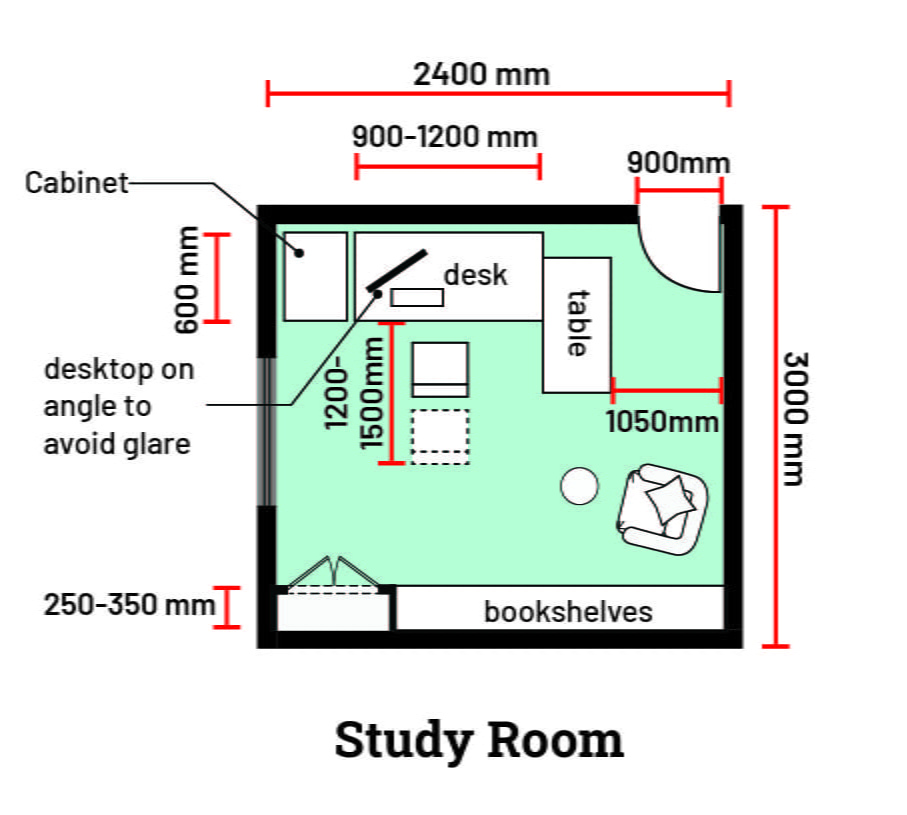
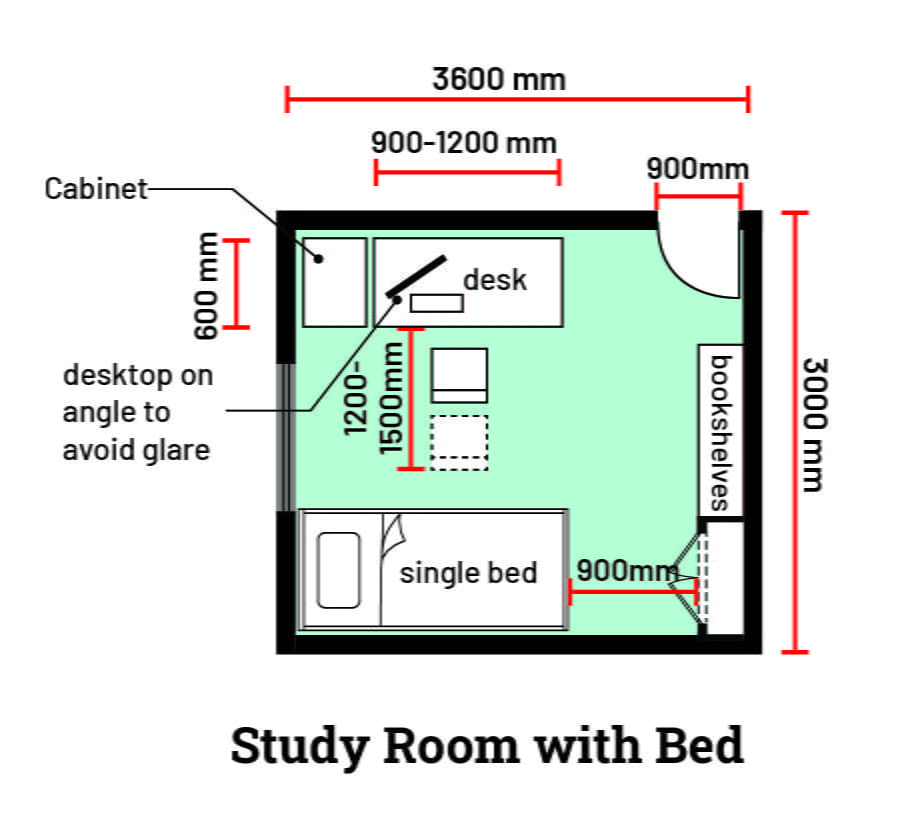
Study Room with Bed
The dimensions of the study room with a small bed should be a minimum of 3000 x 3600 mm (10 x 12 ft.). This much space is suitable for a single bed, a study area, and storage. You can design a bigger study room of 3300 x 3600 mm (11 x 12 ft.) for more space and storage options. The bed used for the study room should be small; don’t place bigger beds as they will require more space and will make the study room congested. A small single bed with dimensions of 1000 x 2050 mm (3 ft. 6 inches x 7 ft.) is perfect for quick naps and resting.
Study room should be designed away from a living room, a family room, or any noisy areas. So that the person working there has privacy, can concentrate on their work, and isn’t disturbed by external noises. This type of study room is suitable for college students and working professionals. It is recommended that you place the bed behind the study area so that you won’t be lured into a quick nap or any other distractions. The layout of the study room with bed is shared above.
Bedroom with study area
A bedroom with a study area offers a harmonious blend of comfort and productivity, serving as a versatile space with several advantages. It optimizes space usage, particularly in small houses where a separate study room cannot be designed.
The dimensions of the bedroom with study area should be a minimum of 3600 x 3600 (12 x 12 ft.). This much space is suitable for a bed, dressing area, study area, and some storage options. A minimum of 2 Sqm. is required for a study area; you can go up to 5 Sqm. depending on the design and luxury of your study area. It is recommended that you place the bed behind the study area so that you won’t be lured into a quick nap or any other distractions. The layout of the bedroom with study area is shared below.
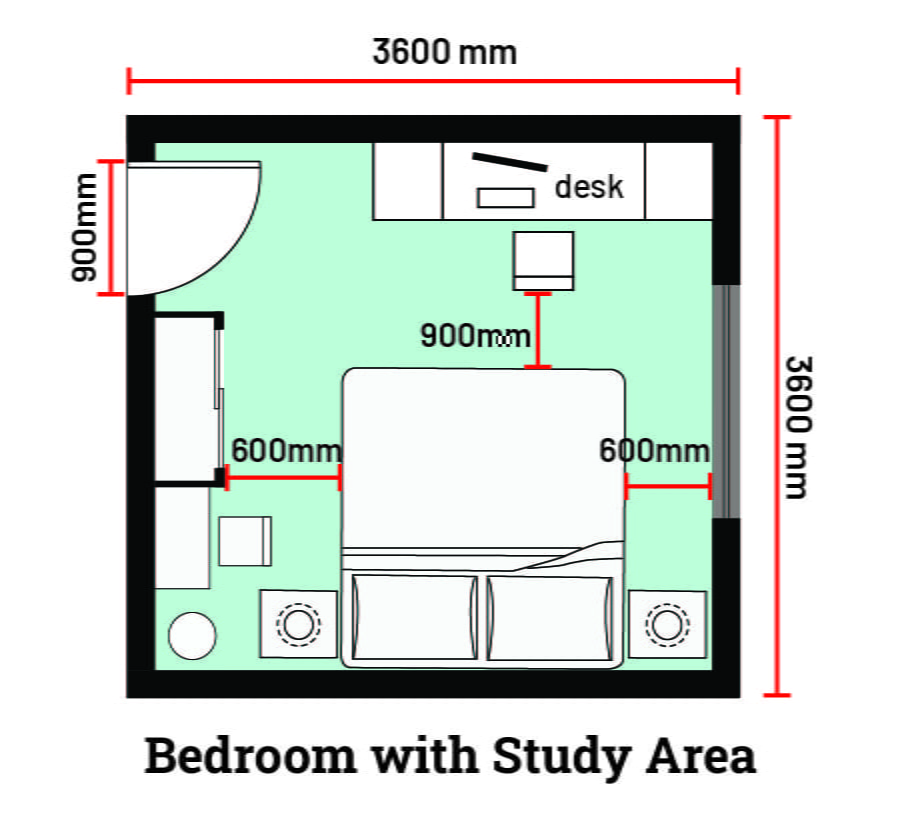
Design Parameters for Study Room
Selection of type of layout for study room or area
- The layout of the study room should be considered based on the user’s demand, available space, and the design of the study room or area. If a minimum dimensions of 2400 x 3000 mm (8 ft. x 10 ft.) of space is available, then you can design a separate study room. If the available area is below the above-mentioned dimensions, then you can’t design a study room. Go for a study area, which can be designed with a bedroom. A bedroom with a study area requires a minimum of 2 Sqm and a maximum of 5 Sqm if you are opting for a bigger and more luxurious study area.
- The preferred shape of the study room is a square or rectangle. Don’t opt for polygon or curve shapes because sharp edges can become distraction points, and it is difficult to arrange furniture in curve layouts. Mainly, curve layouts waste space.
- A layout of the study area can utilize the full length of the wall or can be designed simply at a corner or in the middle of the wall.
Minimum/Maximum height of the furniture
- The average height of the bed (at the top of the mattress) should be 400 to 650 mm (16 to 26 inches), depending on the comfort level of the user.
- The study table should be 750 mm (30 inches) high to ensure a comfortable position when seated.
- Most books have an average depth of 250 to 300 mm (10 to 12 inches). Consider this while designing a bookshelf. Create compartments or shelves based on the categories of the books you have. Place the children’s books on the lower shelves. (Source: IIID Design Handbook)
- A human hand can reach a height of 2100 mm (7 ft.), so designing a bookshelf or bookcase above it is not recommended.
- The standard seating height of a chair should be between 420 to 480 mm (17 to 19 inches).
- The width of the study table should be a minimum of 900 mm (36 inches).
- The gap between the shelves of the bookshelf should be a minimum of 250 to 350 mm (10 to 14 inches), so that different sizes of books can easily be placed on it. It can be wall-mounted or on the floor.
- In the market, chairs are available in a variety of styles and materials. But the width of the chair should be between 420 to 560 mm (17 to 22 inches).
For more standard dimensions of furniture related to study room or area, click here. (You can also download these CAD Blocks, FOR FREE):-
To know about the standard dimensions of study table, chair, desk, bed, cabinets, shelves, and other equipment. You should refer to the Neufert, Timesavers, and other standard books. Or I would prefer going with the booklets or brochures of the companies involved in designing and making those types of furniture and equipment.
Position of Window in Study Room
- The position of the opening or window should be considered with respect to the placement of the study table. The window should be designed in such a such a way that the glare does not reflect on the study table, laptop, or computer. It distracts the user and dissolves his concentration.
- If the window opening is there, then place an overhang strategically so that it cuts the direct light. Opt for blinds and curtains to cover the window.
- Designing a window just above the study table is not recommended because most of the time it will be covered and doesn’t have any benefits to the user.
- Enhance the window by designing a sitting area and book storage options.
Standard Clear space from the furniture
- The minimum width of the door inside a study room should be 900 mm (36 inches).
- The bed should have a clearance of at least 450 to 600 mm (18 to 24 inches) on both sides and in front of the bed for smooth movement, bed making, and circulation.
- Save space by combining the bookshelf and study area into a single unit in the bedroom.
- There should be a clearance of 1200 to 1500 mm (4 ft. to 5 ft.) around the study table. So that a person can sit and work and still have enough circulation space for another person to walk from behind. (Source: IIID Design Handbook)
- The furniture inside the study room should be placed in such a way that it leaves a minimum of 600 to 750 mm (24 to 30 inches) of circulation space. So that it doesn’t cause inappropriate movement and disturbance to the users.
Decoration and Artworks in Study Room
- A visually appealing environment can inspire, bring positivity, increase concentration, and increase the aesthetic of a study room. Incorporating elements like natural light and air, inspiring artwork, greenery, sculptures, posters, and comfortable furniture will make the study area inviting and conducive to learning.
- Precisely selected artworks can evoke emotions, spark imagination, and stimulate thought, providing visual interest and serving as focal points within the room.
- Artworks can serve as sources of motivation and inspiration, helping individuals stay focused and engaged during work or study sessions.
- Incorporating greenery inside or outside the study room brings good vibes, fresh air, and increases concentration.
- A picture of the poster of Lord Ganesha and Maa Saraswati should be placed in the north-east direction of the study room to bring positivity and good luck.
Ergonomics/ Standard dimensions related to Study Room or Area
The ergonomics & dimensions of the study room can be fulfilled by taking care of the facilities and comfort of the users. Below are some standard study room or area dimensions for easy moving, standard living, and ease of studying or working. The study room is a private area. It should be designed in a way that the user studying or working there can concentrate on their work or studying without any disturbance in a good environment. (Source: Neufert, Timesavers, Metric Handbook, Architect’s Handbook, IIID Handbook, etc.)
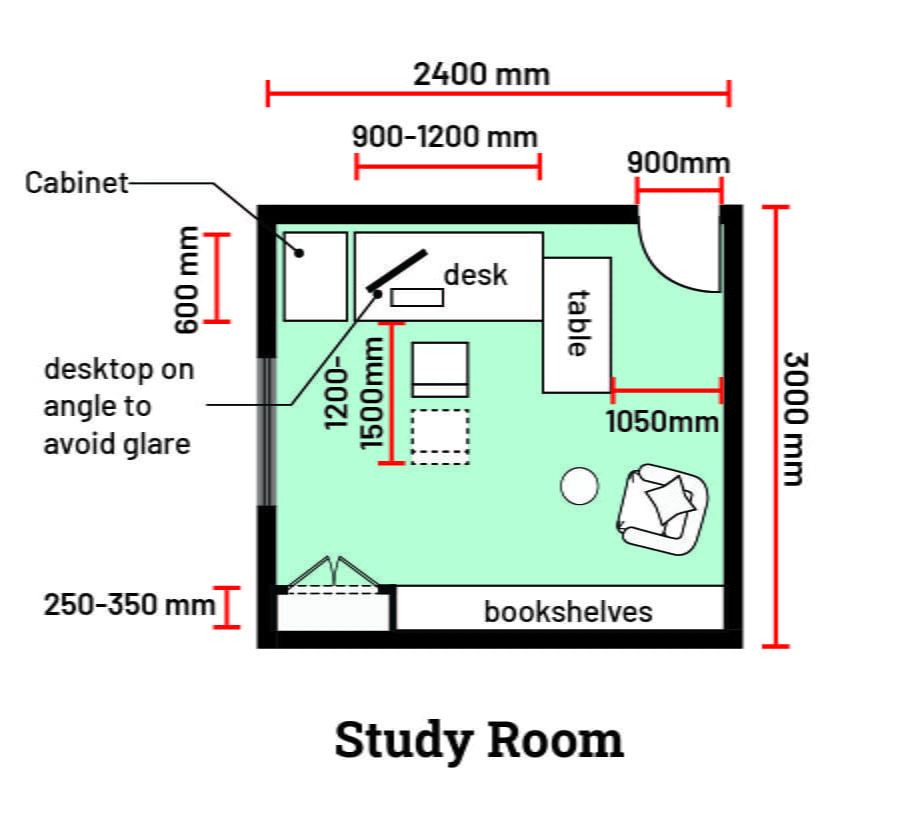
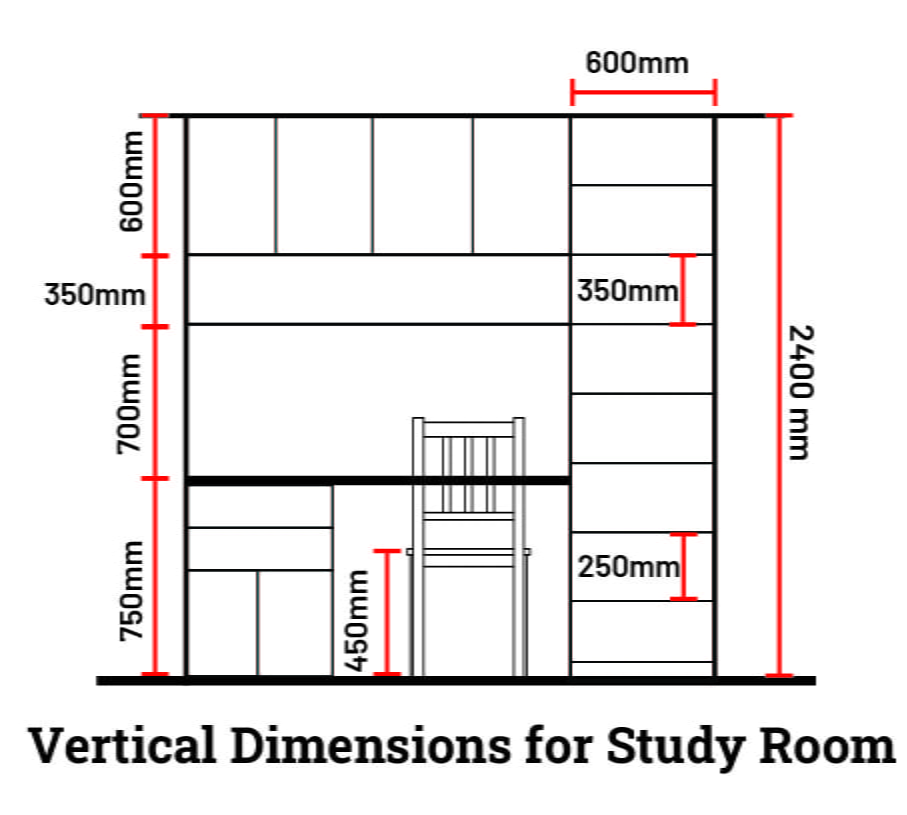
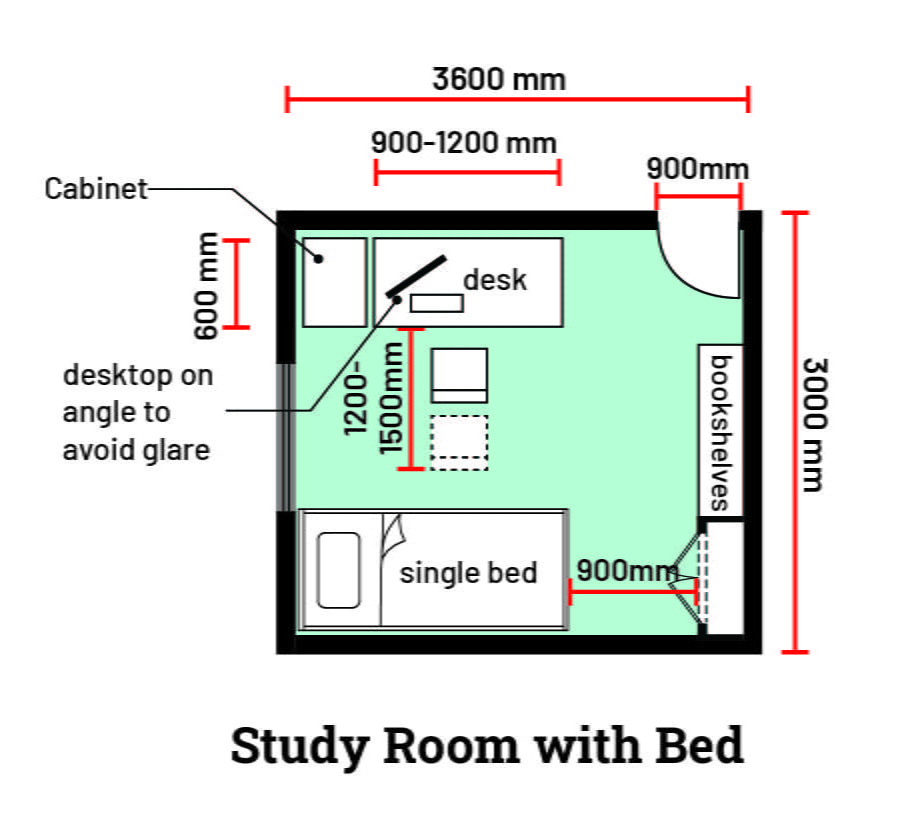
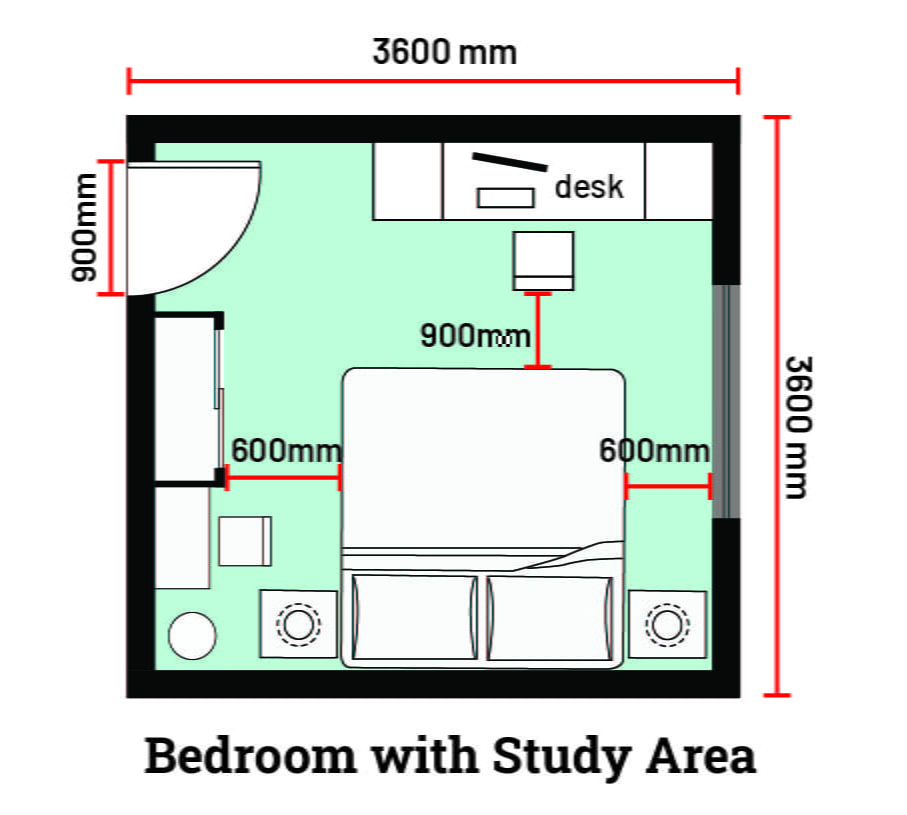
Avoid mistakes while designing the bedroom
Poor circulation
Circulation is the most essential thing to consider while designing any space. If a space doesn’t have enough space for smooth circulation, then it will create chaos, and users will face mainly difficulties while living there. A minimum of 600 to 750 mm (24 to 30 inches) of clear space is required for smooth circulation.
Ignoring the position of the window
As discussed above, the window should be strategically designed for a study room or area for better user convenience. Don’t design a window just above the study table it is not recommended. If the window is designed on the side wall, then place your computer or laptop at an angle so that direct light doesn’t fall on the screen of your device.
Choosing incorrectly sized furniture.
The study room needs concentration and comfort for long hours of working and studying. If the furniture is not of standard dimensions, it can disturb the posture of the user sitting on the chair. That can lead to back pain and stress for the user. That’s why it is necessary to place a standard-height table and chair in the study room. The bookshelf should have a gap of 250 to 350 mm (10 to 14 inches) between shelves so that different sizes of books can be placed.
Not creatively designing the spaces.
Be creative and opt for different types of elements to enhance the beauty of the study room and provide comfort to the user. Use elements like vibrant colors, space-saving furniture, rugs, inspiring artwork, greenery, sculptures, posters, and other inspirational things to stay connected and motivated towards your studies.
Not utilizing vertical space
Don’t just use a bookshelf for storing books. Create a unique design of a bookshelf and wall-mounted shelves for an aesthetic study area. Use space around the window for storage and sitting to provide additional comfort to the user.
A question for the readers
What do you think is the best layout?
Comment with your answers below.
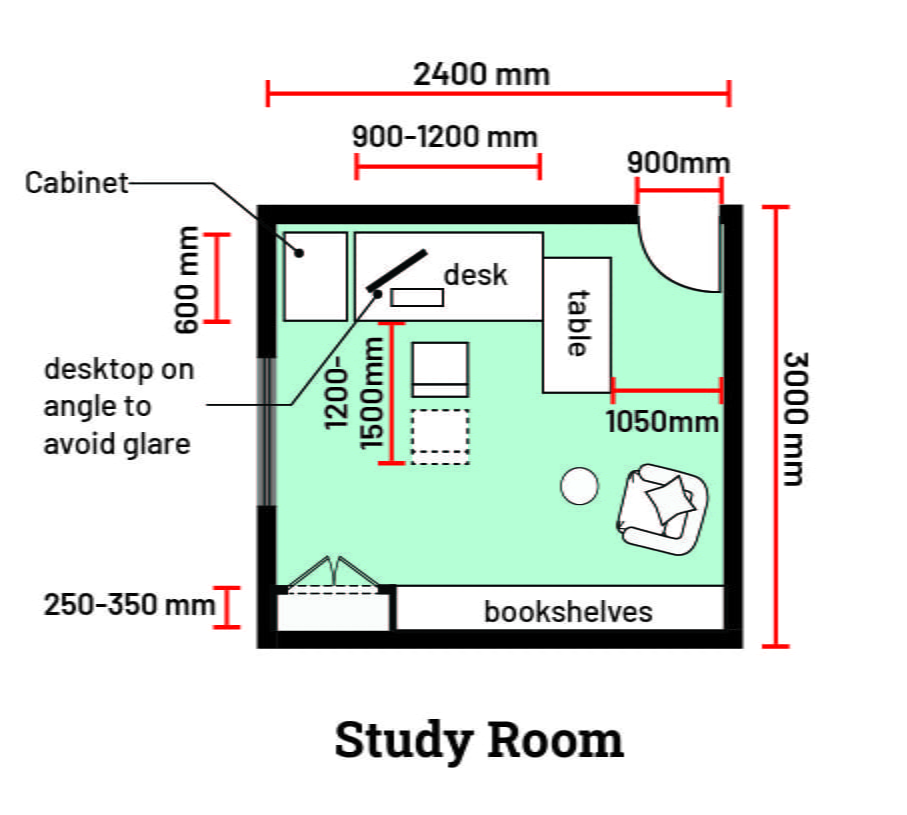
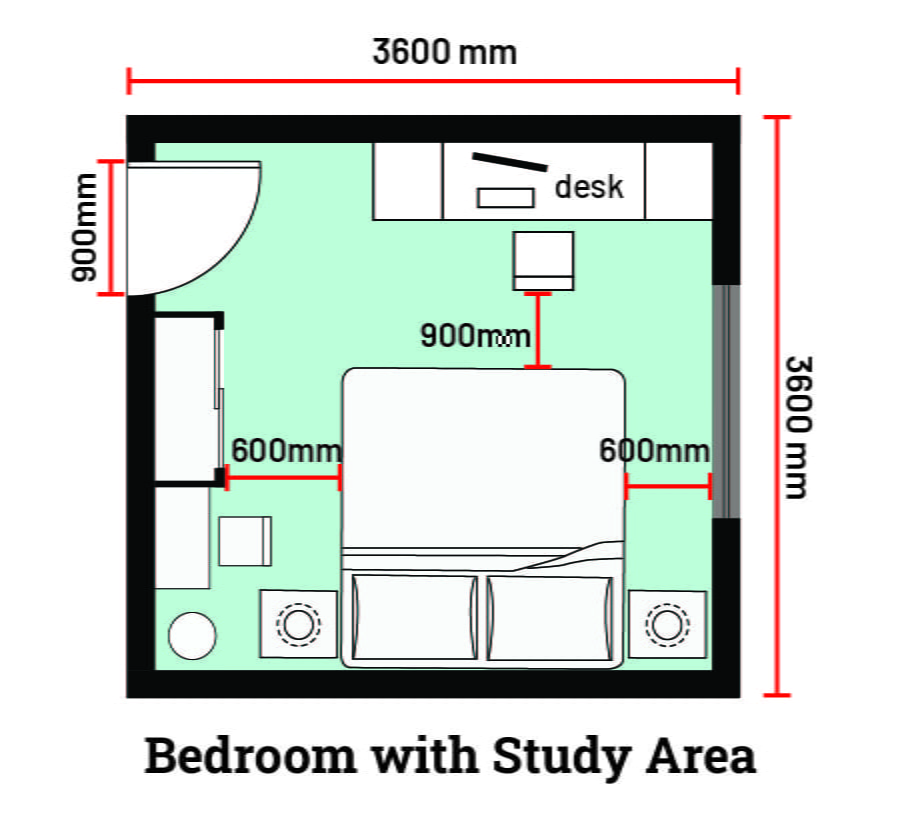
Some of the modern study room or areas design
*Note: The dimensions written in inches and mm are individual dimensions, not converted

